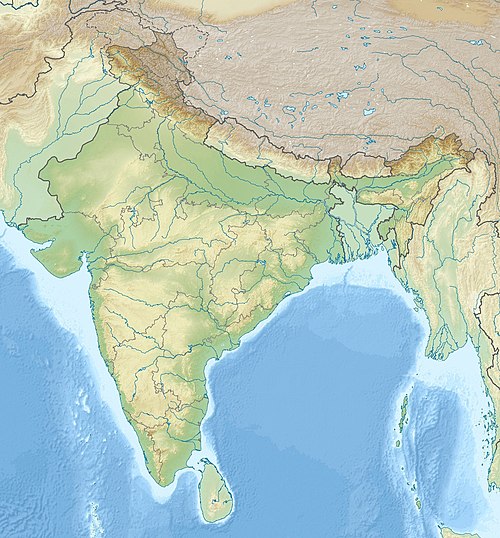Son Bhandar Caves
The Son Bhandar caves, also Sonebhandar, are two artificial caves belong to Jainism (to Ajivikas earlier) are located in Rajgir in the state of Bihar in India. The caves are generally dated to the 3rd or 4th century CE, based on the dedicatory inscription found in the largest cave which uses Gupta script of the 4th century CE, although some authors have suggested the caves could actually go back to the period of the Maurya empire from 319 to 180 BCE.[1][2] The main cave is rectangular with a pointed ceiling, and the entrance is trapezoidal, reminiscent of the structure of the Barabar Caves (the first artificial caves of India, dated the 3rd century BCE).[3] The quality of the "Mauryan polish" and the finish are nevertheless much inferior.[3] The stone of Son Bhandar is also much less hard than the granite of the Barabar caves, and therefore did not require the same degree of effort and technique.[3]
| Son Bhandar Caves | |
|---|---|
Main cave of Son Bhandar with ceiling in Ogive. | |
 | |
| Location | Rajgir |
| Coordinates | 25°01′48″N 85°25′12″E |
Dedicatory inscription of the 4th century CE
An inscription in the rock at the entrance of the cave in Gupta characters of the 4th century of our era mentions the construction of the cellar by a Jain Muni ("wise man") named Vairadeva. This inscription naturally led to date the cave to the same period of the 4th century CE.:[3]

Muni Vairadeva, the jewel among the acaryas and of great lustre, caused to be made the two auspicious caves which are worthy of ascetics and in which were placed the images of arhats (ie tirthankaras)
— Inscription of the main Son Bhandar cave (4th century CE).[3]
According to Gupta, however, this inscription may be ambiguous and, for him, might only mean that the cave was the subject of re-development work at that time. For this reason, he tends to date the cave on the basis of its similarities with the caves of Barabar (general shape, trapezoidal entrance door, polishing, although extremely limited) to the time of Ashoka (260 BCE), or even a little earlier, making it the possible precursor of all artificial caves in India such as the Barabar Caves.[3] Le Huu Phuoc also entertains the possibility, to challenge the traditional idea that stone mirror-polishing techniques were imported from the Near East.[5] The consensus, however, favours the traditional datation of 2nd to 4th century of our era, based on the epigraphic evidence.
The ancient Saptaparni Cave, a natural cave dating back to the days of the Buddha, is only a few kilometers away.
Main Cave
The cave dates were built during rule of Maurya empire during 319 to 180 BCE.[2][6]
 Outside of the cave.
Outside of the cave. Trapezoidal Entrance
Trapezoidal Entrance Inside the cave, with votive Jain stele.
Inside the cave, with votive Jain stele. The Jain stele.
The Jain stele. Partially polished surface .
Partially polished surface . Volume map of the main cave.
Volume map of the main cave. Plan the main cave and the second small cave next to it.
Plan the main cave and the second small cave next to it.
Second cave
The second cave, adjacent to the main cave, is largely destroyed, but it has some beautiful Jains reliefs. This cave dates back to the 3rd and 4th century AD.[6]
 Main cave and second cave in the background.
Main cave and second cave in the background. Facade of the second cave.
Facade of the second cave. Inside wall of the second cave, with sculptures.
Inside wall of the second cave, with sculptures. Jain sculptures of the second cave.
Jain sculptures of the second cave. Jain sculptures of the second cave.
Jain sculptures of the second cave.
References
Citation
- Balcerowicz, Piotr (2015). Early Asceticism in India: Ājīvikism and Jainism. Routledge. p. 299. ISBN 9781317538530.
- Burgess 1880, p. 49.
- Gupta, The roots of Indian Art, B. R. Publishing Corporation, Delhi, 1980 p. 194-200
- Cunningham, Four Reports Made Durning The Years 1862-65 Vol.1
- Buddhist Architecture, Grafikol 2009, Le Huu Phuoc, p.45
- Kulshreshtha 2017, p. 135.
Sources
- Burgess, James (1880), The Cave Temples of India, Cambridge University Press, ISBN 9781108055529
- Kulshreshtha, Salila (2017), From Temple to Museum (Colonial Collections and Umā Maheśvara Icons in the Middle Ganga Valley ed.), Taylor & Francis, ISBN 9781351356091